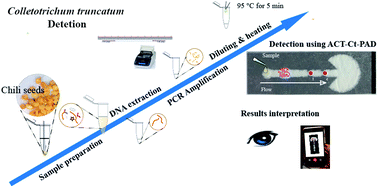A new and high-performance microfluidic analytical device based on Fusion 5 paper for the detection of chili pepper anthracnose pathogen Colletotrichum truncatum†
Abstract
A microfluidic analytical device based on wax-patterned Fusion 5 paper was designed and fabricated to facilitate early detection and improve control of anthracnose disease. Here, a rapid, specific, on-site, and low operational cost nucleic acid biosensor (ACT-Ct-PAD) based on the actin gene (ACT) and wax-patterned Fusion 5 paper was used to detect the PCR products of Colletotrichum truncatum (Ct), the main causal agent of chili anthracnose in Asia. The sensor was developed by using DNA conjugated gold nanoparticles (AuNPs-DNA) as a detection probe, which will hybridize to a complementary target sequence. Avidin coated mesoporous silica particles were attached to biotin-tagged DNA sequences forming capture probes, which were immobilized on the test and control zones of the device. The hybridization complex (MSP-dsDNA-AuNPs) produces an intense red color, which provides a platform for colorimetric detection. By targeting an actin gene sequence, the ACT-Ct-PAD device allows the detection of Ct DNA within 15 min. The specificity of the sensor was confirmed by the absence of a positive signal for DNA from non-target Colletotrichum species and two different fungal genera. Our wax-patterned Fusion 5 sensor provides a simple tool for the rapid nucleic acid diagnosis with a detection limit down to 17.42 femtomoles. This method has the potential to be applied for protein assay as well; hence, it has a considerable impact on on-site diagnostics.



 Please wait while we load your content...
Please wait while we load your content...